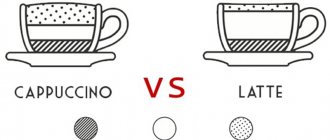First, a couple of tips on how to make cappuccino foam if you don’t have a coffee machine with suitable functionality in your kitchen. First of all, the milk needs to be heated to 80 degrees, that is, until the first bubbles appear on the surface. Now we select the appropriate equipment. A whisk, fork, or small French press works best. Pour warm milk into it and begin to quickly raise and lower the moving part. The process may take a couple of minutes, but the result will surely please you! The strength of milk foam depends on the protein content of the drink and the percentage of fat content. Moreover, this applies not only to plant milk, but also to regular cow’s milk. Many manufacturers produce special “professional grades” for ideal foaming. But don't be discouraged if you can't find them in the store. Let's look at the alternatives.
Everything you need to know about milk alternatives in coffee
Today, more and more people are abandoning animal milk. Some do it for ethical reasons, others for health reasons, and others follow fashion. Be that as it may, plant-based milk is confidently gaining popularity. Therefore, any modern coffee shop that strives to keep up with the latest trends cannot do without meatless alternatives. This will make the menu more varied and attract guests who, for one reason or another, have given up cow's milk.
We spent a lot of time testing plant-based analogues and ruined quite a few cups of coffee with them before we figured out what was what. And here is the main thing we managed to find out:
Coffee palette in the interior: walls, floor and ceiling
The brown color palette has a huge number of shades. From the color of milk chocolate to the darkest - rich chocolate. All these shades are warm and cozy. Their distinctive feature is their amazing softness of perception. They exude reliability and age-old regularity.
This design will make you smile and not fall into a blues.
Evokes associations with aromatic coffee or dark chocolate. This is the color of the classical style with its nobility and aristocracy.
Red-brown is a luxurious representative of the Victorian style with its stability and conservatism. The color of red furniture made from expensive solid wood will also suit the brilliant art deco.
Yellow-brown will be appropriate in ethnic styles: wooden Russian, sultry African or luxurious Egyptian. This is an optimistic color of cheerful comfort and good mood.
Taupe or taupe is a discreet background for a solid Scandinavian style. An excessive amount of gray in decorative details will make this shade of brown uncomfortable and faded.
The light brown shade hides comfort and tranquility. This shade is conducive to quiet family evenings with a cup of coffee and intimate conversations in a close circle.
Ideal partners for brown shades in interior design:
- Relaxed beige and soft milky will lead to a self-sufficient union. Combining colors with milky color comes with the added warmth of this shade.
- Optimistic orange will give positive energy and add joy. White shades will fit into this duet and give the interior lightness and airiness.
- Blurred yellow will bring a bit of regularity and detachment. Better to use as a background.
- Fresh green will add coolness. Light shades are distinguished by restraint, and dark ones – by elegance.
- Rich gold will highlight the sophistication of the design in brown tones. This color is best used only for decorative elements.
- Reliable blue will bring practicality to the interior of a brown kitchen.
This kitchen creates an exquisite picture of the interior
Not all plant-based milk is created equal
Unlike cow's milk, plant milk can vary in composition. Almond, hemp and soy milk sound very healthy and progressive. But don't be fooled: In my research, I found that many barista-friendly alternative milks contain thickeners, sugar, and other chemical additives. Therefore, the next time you go to your favorite coffee shop, don’t be shy to ask to see a milk carton. Take a look at the ingredients and remember the manufacturer. A simple rule works here: the fewer ingredients and artificial sweeteners, the better. We especially recommend avoiding carrageenan - this substance causes irritation and inflammation of the gastrointestinal tract - Carrageenan consumption can also cause inflammatory bowel disease.
©CoffeeProjectTeam
If the composition does not satisfy you, do not forget to inform the barista about it. In small establishments, owners often work as baristas themselves. Or, as an option, ask to report suspicious ingredients to the management of the coffee shop. With this you will improve the life, health and taste sensations of other lovers of almond lattes and rice cappuccinos











